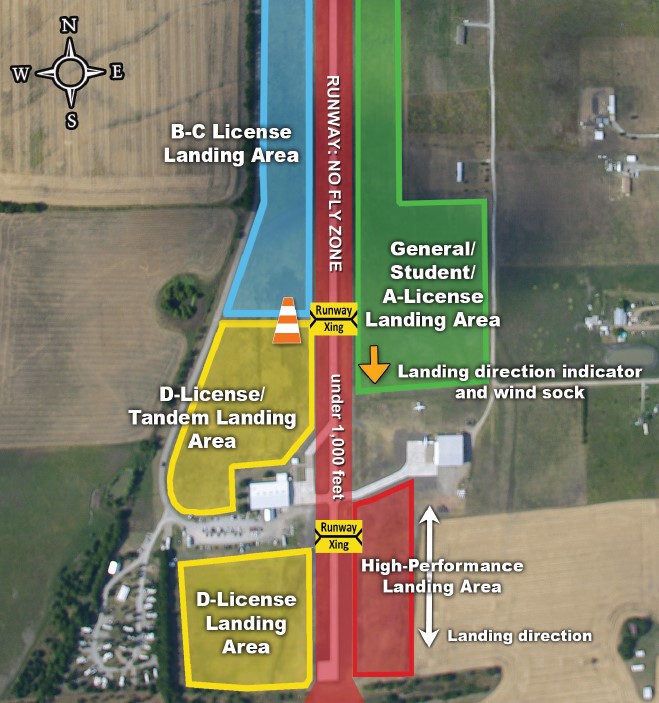When we were kids, pretty much everyone who took care of us taught us to look both ways before crossing any street. Right? This was probably one of the rare pieces of advice most of us didn’t challenge too much, because no one wants to get hit by a car!
Why, then, do we not apply the same logic to crossing the runway at an active airport, especially one as busy as a dropzone? At drop zones where jumpers must cross the runway on foot to get back to the staging area after landing, jumpers crossing the runway in front of operating aircraft (or almost doing so) is inexplicably common. This is called a runway incursion, which is defined as “any occurrence at an aerodrome involving the incorrect presence of an aircraft, vehicle or person on the protected area of a surface designated for the landing and take off of aircraft.”
Heath Richardson, chief pilot for Skydive Spaceland Dallas, comments, “Runway incursions have directly caused many major aircraft accidents worldwide, resulting in significant loss of life. It’s not just the individual jumper and a single pilot, but up to two dozen (or more) souls aboard each jump plane that are potentially endangered.”
Skydiver/runway incursions are likely a simple result of jumpers being jazzed up on adrenaline after a skydive and being distracted by discussing the awesome jump with your friends, but regardless of why they happen, there are both obvious and less obvious reasons why this is a really bad idea.
Reason 1: It’s Really Bad for Everyone’s Health (obvious)
Those spinny things on the fronts of most commonly used skydiving aircraft will do even more damage to you than a car! In the contest between you and a spinning prop, you’ll both lose. You’ll be severely injured at best, and the prop strike will require an engine teardown before returning to service–also at best. At worst, you’re dead, the pilot and passengers are injured or worse, and the airplane sustains further damage to its hull, wings, and/or landing gear in addition to the prop and engine damage. #dontbethatguyorgirl
Reason 2: Airplanes Aren’t Cars (kind of obvious)
“This baby handles like it’s on rails!”
“This thing stops on a dime!”
Said no one about an aircraft while taxiing, taking off, or landing, EVER.
Airplanes are designed to fly, with ground driving (taxiing) performance as a distantly secondary priority. Taxiing is what you have to do with an airplane to get it to and from the runway for its real job of flying. An airplane on the ground, whether it’s taxiing slowly or going faster for takeoff or after landing, is not a nimble and responsive machine like a car. If it’s taxiing slowly, it can at least stop quickly, but if you cross the runway in front of an airplane that’s rolling at speed for takeoff or just after landing, it simply can’t stop very fast and it can’t even turn off the runway to avoid you without risking major damage. We all know how poorly it can go when a car runs off the road…
Because airplanes aren’t nimble on the ground, pilots don’t like to cut it close with people crossing in front of them. They have to take evasive action long before an unaware jumper may even be aware there is a problem. Help a pilot out… NEVER cross the runway without looking both ways to see if an airplane is pointed at you. If it is, don’t cross. Simple as that.
Awareness = Prevention
Runway/airplane awareness tends to be lower for jumpers who mostly jump at dropzones where they never or rarely have to walk across the runway, such as Skydive Arizona. Conversely, jumpers who call Skydive Perris or Skydive Spaceland Dallas home are pretty accustomed to crossing the runway routinely, so they will often be more aware of proper runway crossing procedures. Visitors to such drop zones, or regulars who land out on the other side of any active runway, should do the following:
- If there is a designated runway crossing point, only cross there. Yes, it may be a longer walk. Land closer to the crossing point next time.
- Once you reach the crossing point, look both ways for airplanes pointed at you (if you haven’t already done so while you were walking up). Don’t just look on the ground, also look up off the ends of the runway in case an airplane is approaching to land. Don’t count on hearing the airplane, especially if you still have your helmet on and/or are wearing earplugs or earbuds playing music. Also note that aircraft may be coming from either direction at any time, especially on a light/variable wind day; don’t assume you know the aircrafts’ traffic patterns as patterns may change with the winds throughout the day just like canopy landing patterns/directions. One more thing: Even if your dropzone only operates one aircraft, other aircraft may use the runway especially if it’s a municipal airport. Don’t just check the dropzone aircraft off and stop looking for aircraft; keep your head on a swivel for ANY operating aircraft until you’re back in the staging area.
- If an airplane is pointed at you, DO NOT CROSS. Stop double the airplane’s wingspan away from the runway (often there will be cones or other markers you should stay behind) and take a knee (kneel) to show the pilot you see them and will not cross in front of them. Look nearby for other jumpers from the load who may be approaching to cross and make sure they stop and take a knee as well.
- If no airplane is pointed at you, cross but don’t be slow about it. The runway is LAVA!!!! Don’t stop, hang out there, and chat with your friends! (Seems silly to say, but we’ve seen it happen more than once!)
“It seems that the mindset is often one of: ‘There are occasionally airplanes where I skydive,’ ” says Richardson. “The opposite is true and should be remembered at all times while on any airfield: ‘I am on an active airport, where I am a guest as a skydiver.’ ”
Be aware and safe out there!


